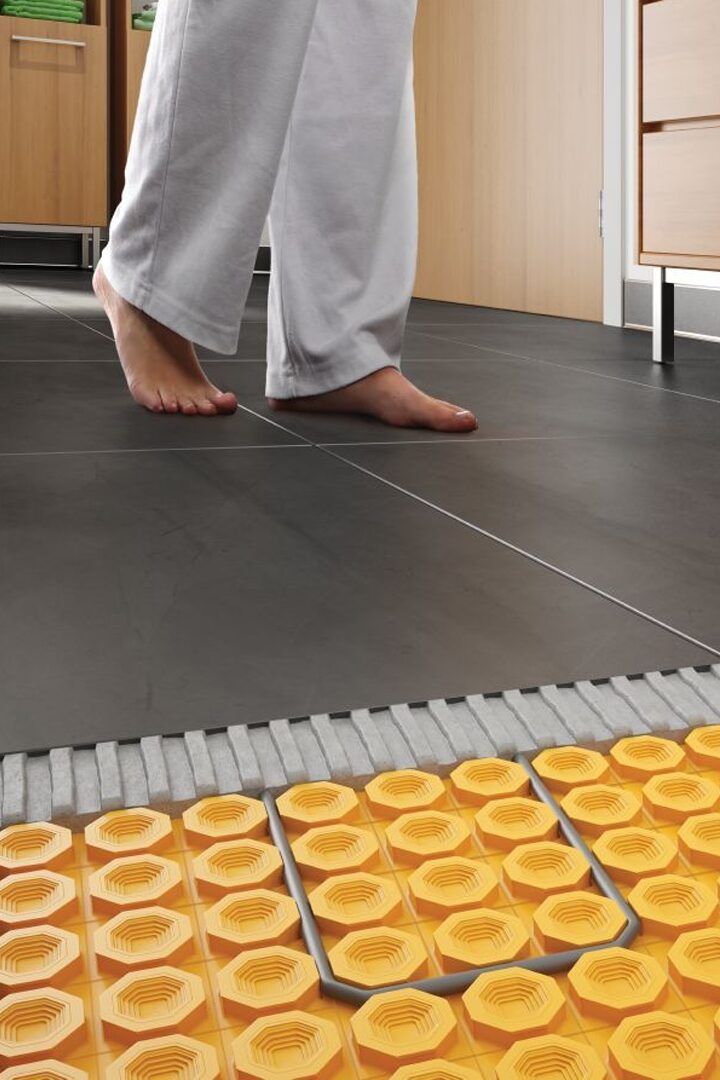Heated floors, also known as radiant floor heating, represent a pinnacle of home comfort: Especially in New England, cold floors throughout your hallways and bathrooms can be a nasty wake up call in the mornings. As comfort becomes a higher priority in remodeling and design, these systems are becoming increasingly popular in various parts of the home, including bathrooms, kitchens, and living rooms. They provide uniform warmth throughout your flooring, which enhances the overall comfort of any living space. In bathrooms, heated floors can be installed as full-room heating solutions or as targeted in-shower heating, and radiant floors tend are a great fit for cold tile floors in winter.
The concept of heated floors isn’t new. It dates back to ancient Rome, where the hypocaust system was used to heat public baths and private houses. The hypocaust system involved circulating hot air through a network of channels beneath the floor, warming the surface above. Modern heated floor systems, though more advanced, follow a similar principle. They use electric cables, hydronic tubing, or radiant mats to generate and distribute heat, providing efficient and consistent warmth throughout the room. In this article, we’ll run through the dominant brands of underfloor heating, and talk about the main types products on the market and their individual benefits and drawbacks. If you’re looking at taking on a kitchen or bathroom remodel or home addition with heated flooring, this is a great place to get a foothold on the different products out there!

Brand Overview
When considering heated floor systems, several brands stand out for their quality, reliability, and innovation. Among these, Schluter is a well-known name in the industry. Schluter offers the Ditra-Heat system, which integrates heating cables within a specially designed uncoupling membrane. This system is highly regarded for its ease of installation and compatibility with various flooring types, making it a versatile choice for different home environments.
Other notable brands include:
- Warmup: Warmup is known for its extensive range of electric underfloor heating solutions. Their products are designed to offer flexibility for different room sizes and floor coverings, ensuring that homeowners can find the perfect match for their specific needs.
- Nuheat: Nuheat specializes in custom-designed electric mats tailored to fit specific room layouts. This customization ensures optimal heat distribution and efficiency, making Nuheat a popular choice for homeowners looking for personalized heating solutions.
- Uponor: Uponor is a leader in hydronic heating systems. Their products are known for their reliability and efficiency, offering excellent solutions for whole-house or zone-specific heating needs.
Electric vs. Hydronic Heated Floors
Electric Heated Floors
Electric heated floors use a network of electric cables or mats installed beneath the flooring. When an electric current passes through these cables, they generate heat, which is then radiated upwards, warming the floor and the room. The system is typically controlled via a thermostat, allowing precise temperature regulation. This ensures consistent comfort and energy efficiency.
Pros:
- Easy to install, especially in smaller areas.
- Quick heating response time, providing immediate comfort.
- Compatible with various flooring types, including tile, stone, and laminate.
- Ideal for renovations or retrofits due to minimal impact on existing structures.
Cons:
- Higher operating costs compared to hydronic systems, especially for larger areas.
- Best suited for smaller areas due to energy consumption considerations.
- Requires careful planning to avoid overheating or underheating specific zones.
Best Uses:
- Bathrooms: Provides warm, comfortable floors that enhance the bathing experience.
- Kitchens: Keeps the floor warm, especially useful during colder months.
- Small to medium-sized rooms: Offers efficient heating for spaces where conventional heating may not be as effective.
Main Brand Products:
- Schluter Ditra-Heat System
- Warmup StickyMat System
- Nuheat Standard Mat
Hydronic Heated Floors
Hydronic heated floors utilize a network of tubes embedded in the floor through which heated water is circulated. The water is heated by a boiler and then pumped through the tubes. As the hot water flows through the system, it radiates heat into the floor above. This method provides a comfortable, even heat that is highly efficient and effective for large areas or entire homes.
Pros:
- More energy-efficient for large areas or whole-house heating.
- Provides consistent, even heat distribution across the entire floor.
- Lower operating costs over time, making it a cost-effective solution for extensive heating needs.
- Can be integrated with existing home heating systems for added efficiency.
Cons:
- Higher initial installation cost due to the complexity of the system.
- More complex installation process, requiring a boiler, pump, and extensive tubing network.
- Installation may require significant modifications to the home’s existing structure.
- Longer heating response time compared to electric systems.
Best Uses:
- Whole-house heating: Ideal for providing uniform heat throughout the home.
- Large rooms: Ensures consistent warmth without the need for multiple heating units.
- Areas with high heating demands: Efficiently meets the heating needs of large, open spaces.
Main Brand Products:
- Uponor Quik Trak
- Viega Climate Mat
- Watts Radiant PEX Tubing
Overall Comparison
Choosing between electric and hydronic heated floors requires careful consideration of various factors including your space requirements, budget, and long-term heating objectives. Here, we delve into a comparative analysis of these two prominent heated floor systems.
- Electric Heated Floors are ideal for smaller areas and retrofits due to their ease of installation and quick heating response. They are versatile and compatible with various flooring types but have higher operating costs and are less energy-efficient for large spaces.
- Hydronic Heated Floors are best for large areas and whole-house heating due to their superior energy efficiency and consistent heat distribution. They have higher installation costs and maintenance requirements but offer lower operating costs and a higher comfort level over time.
| Electric Heated Floors | Hydronic Heated Floors | |
|---|---|---|
| Installation Cost | ⭐⭐⭐⭐ (Lower) | ⭐⭐ (Higher) |
| Operating Cost | ⭐⭐ (Higher) | ⭐⭐⭐⭐ (Lower) |
| Energy Efficiency | ⭐⭐⭐ | ⭐⭐⭐⭐ |
| Ease of Installation | ⭐⭐⭐⭐ (Easier) | ⭐⭐ (Complex) |
| Heating Response Time | ⭐⭐⭐⭐ (Quick) | ⭐⭐ (Slower) |
| Versatility | ⭐⭐⭐⭐ | ⭐⭐⭐ |
| Maintenance Requirements | ⭐⭐⭐⭐ (Low) | ⭐⭐ (Higher) |
| Best for Small Areas | ⭐⭐⭐⭐ | ⭐⭐ |
| Best for Large Areas | ⭐⭐ | ⭐⭐⭐⭐ |
| Compatibility with Flooring Types | ⭐⭐⭐⭐ | ⭐⭐⭐⭐ |
| Comfort Level | ⭐⭐⭐ | ⭐⭐⭐⭐ |
| Ideal for Retrofits | ⭐⭐⭐⭐ | ⭐⭐ |
| Longevity | ⭐⭐⭐⭐ | ⭐⭐⭐⭐ |
| Noise Level | ⭐⭐⭐⭐ | ⭐⭐⭐⭐ |
| Safety for Pets | ⭐⭐⭐⭐ | ⭐⭐⭐⭐ |
Other Things to Consider
Conclusion
Choosing between electric and hydronic heated floors depends on various factors, including your specific needs, budget, and the space you’re working with. Electric heated floors are ideal for smaller areas and retrofit projects due to their ease of installation and quick heating response. They offer great flexibility and are relatively low-maintenance, making them suitable for DIY enthusiasts and smaller renovations.
On the other hand, hydronic heated floors are best suited for large areas or whole-house heating. They provide consistent, even heat and are more energy-efficient in the long run, despite the higher initial installation costs and more complex setup. Hydronic systems require more regular maintenance but offer superior comfort and lower operating costs over time.
Both systems have advanced control interfaces, allowing for remote operation, smart assistant connectivity, and detailed scheduling. This enhances user convenience and energy management, ensuring that your home remains comfortable and efficient.
Ultimately, the best choice for your home will depend on your specific requirements, the size of the area you wish to heat, and your long-term goals for comfort and energy efficiency.
Further Reading
For more detailed information on heated floor systems, consider these resources:







